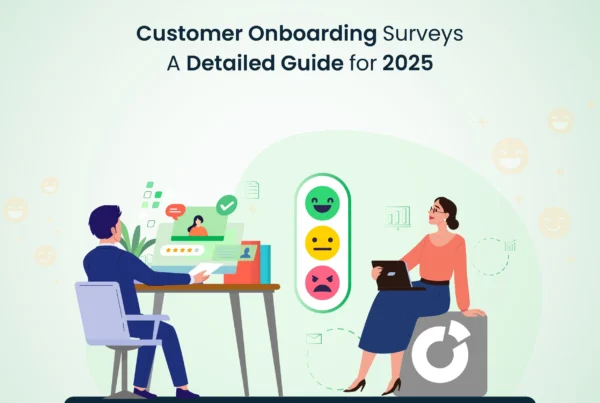Yes or no surveys are one of the easiest ways to collect quick and meaningful feedback. These types of questions, also known as dichotomous questions, only offer two answer options: yes or no. That’s it. No scales, no dropdowns, no complicated forms.
Just two choices that make it super simple for people to respond. Because they’re so quick and easy, yes or no questions are great for understanding what customers like, don’t like, or what’s working and what’s not.
Check out this blog to know how yes or no surveys can help you get the answers fast.
What are the benefits of yes or no surveys
Here are some of the most common and practical benefits of using yes or no questions in your surveys:
1. Ease of use
One of the biggest reasons yes or no survey questions work so well is because they’re incredibly easy to answer. There’s no need for the respondent to think too hard or scroll through a list of options. All they need to do is choose between “Yes” or “No”—it takes a second or two, and they’re done.
2. Clear and direct feedback
Yes or no questions give you feedback that’s black and white—literally. There’s no room for interpretation. You either get a “yes” or a “no,” which makes it easier to understand what your customers or users are thinking. Unlike scaled responses where people might interpret “4 out of 5” in different ways, yes or no questions leave no space for confusion.
3. Better response rates
Lengthy surveys often scare people away. If they see a page full of long, detailed questions, there’s a good chance they’ll abandon it halfway or never start it at all. Yes or no surveys, on the other hand, look quick and manageable right from the beginning. Because they require less effort, people are more likely to complete them. This leads to a higher participation rate.
4. Flexible for different use cases
Yes or no questions are incredibly versatile and can be used across many types of surveys. Whether you’re running a market research survey, trying to measure customer satisfaction, checking service quality, collecting product feedback, or conducting an internal team pulse check, you can always include a few well-placed yes or no questions.
5. Quick feedback collection
Sometimes, you just need fast answers. Yes or no survey questions are ideal for these situations. Because they’re short and to the point, respondents don’t have to spend time analyzing their feelings or selecting from many choices. This makes it easy to collect feedback in real-time, like at the end of a customer support chat, after an in-store purchase, or following a training session. You get immediate input that you can act on quickly.
6. Easy to analyze and report
When there are only two possible answers, it becomes much easier to go through the data and draw conclusions. You can clearly see what percentage of people said “yes” and how many said “no.” This simplicity helps when you’re generating reports, identifying trends, or trying to make data-backed decisions.
Best strategies for using yes or no questions in surveys
Yes or no questions may look simple, but there’s a smart way to use them if you want more accurate and useful feedback. Here are some of the best strategies to make your yes or no surveys more effective:
1. Keep the survey short: The whole point of using yes or no survey questions is to keep things quick and easy. Don’t overload your survey with too many questions. A few well-placed yes or no questions can do the job better than a long list.
2. Use clear and simple language: Avoid complicated words or confusing sentences. Your yes or no questionnaire should be short, to the point, and easy to understand at a glance. Instead of “Do you find our onboarding process sufficiently intuitive?” say “Was it easy to get started?”
3. Maintain logical flow: Make sure your questions follow a proper order and make sense as a sequence. For example, don’t ask “Did you like the feature update?” before asking “Did you try the new feature?” Use logic jumps or branching in the feedback survey to skip irrelevant questions.
4. Simple and clean survey design: Don’t clutter your survey with too many elements. Use a clean layout, readable fonts, and enough space between the question and answer buttons. Keep it visually light so that people can focus on the questions without distractions.
5. Add an open-ended follow-up: After a yes or no question, you can add a follow-up like “Can you tell us why?” This helps you get more detailed feedback without overwhelming the user. It gives them the option to share more if they want to.
6. Don’t overuse yes or no: Yes or no questions are great but only when used in the right places. Not every question fits into a yes or no format. Use them where they make sense and mix in other types when deeper responses are needed.
7. Test before sending: Always test your survey before launching it. Make sure all logic jumps work correctly, mobile display looks good, and that the questions feel natural to answer.
Top yes or no questions for different feedback scenarios
Yes or no questions can be used in many different situations, from checking customer satisfaction to collecting internal team feedback. Below are some common scenarios and sample yes or no survey questions you can use for different scenarios.
1. Product feedback
Want to know what users think about your product? These quick questions can help:
- Did the product meet your expectations?
- Was it easy to use the product?
- Did you face any issues while using the product?
- Would you use this product again?
- Did you find the product features useful?
2. Customer satisfaction
To understand how happy customers are with your service or interaction:
- Were you satisfied with our service today?
- Did our team resolve your issue?
- Was the wait time acceptable?
- Did you feel valued as a customer?
- Would you like to be contacted for further support?
3. Website or app experience
Check if your digital platforms are working smoothly:
- Was it easy to navigate the website/app?
- Did you find the information you were looking for?
- Was the page loading speed satisfactory?
- Did you complete your task without issues?
- Would you return to use the platform again?
4. Employee feedback
Quick internal checks to monitor employee mood and engagement:
- Do you feel motivated at work?
- Are you satisfied with the support from your manager?
- Do you find your current workload manageable?
- Do you feel recognized for your work?
- Would you recommend this company as a good place to work?
5. Event or session feedback
Useful after meetings, webinars, or events:
- Was the event informative?
- Did the session meet your expectations?
- Was the speaker clear and engaging?
- Would you attend another session like this?
- Was the registration and joining process smooth?
6. Service quality checks
Perfect for businesses like hospitality, healthcare, or retail:
- Was our staff helpful today?
- Did you find the service quick and efficient?
- Was the place clean and well-maintained?
- Did you receive everything you needed?
- Would you come back again?
Wrapping up
Yes or no questions are simple, but they’re a smart way to collect quick and meaningful feedback. They make it easier for people to understand and respond quickly. Whether you want to conduct a short survey on your website, check in with employees, or collect feedback after a purchase, yes or no surveys can get the job done fast.
All you have to do is keep your questions clear, your surveys short, and always think about what you’ll do with the answers you get. Add follow-up questions when needed, and you’ll be able to turn simple yes/no answers into valuable insights. Schedule a demo with piHappiness to use yes or no questions and gather valuable feedback.








